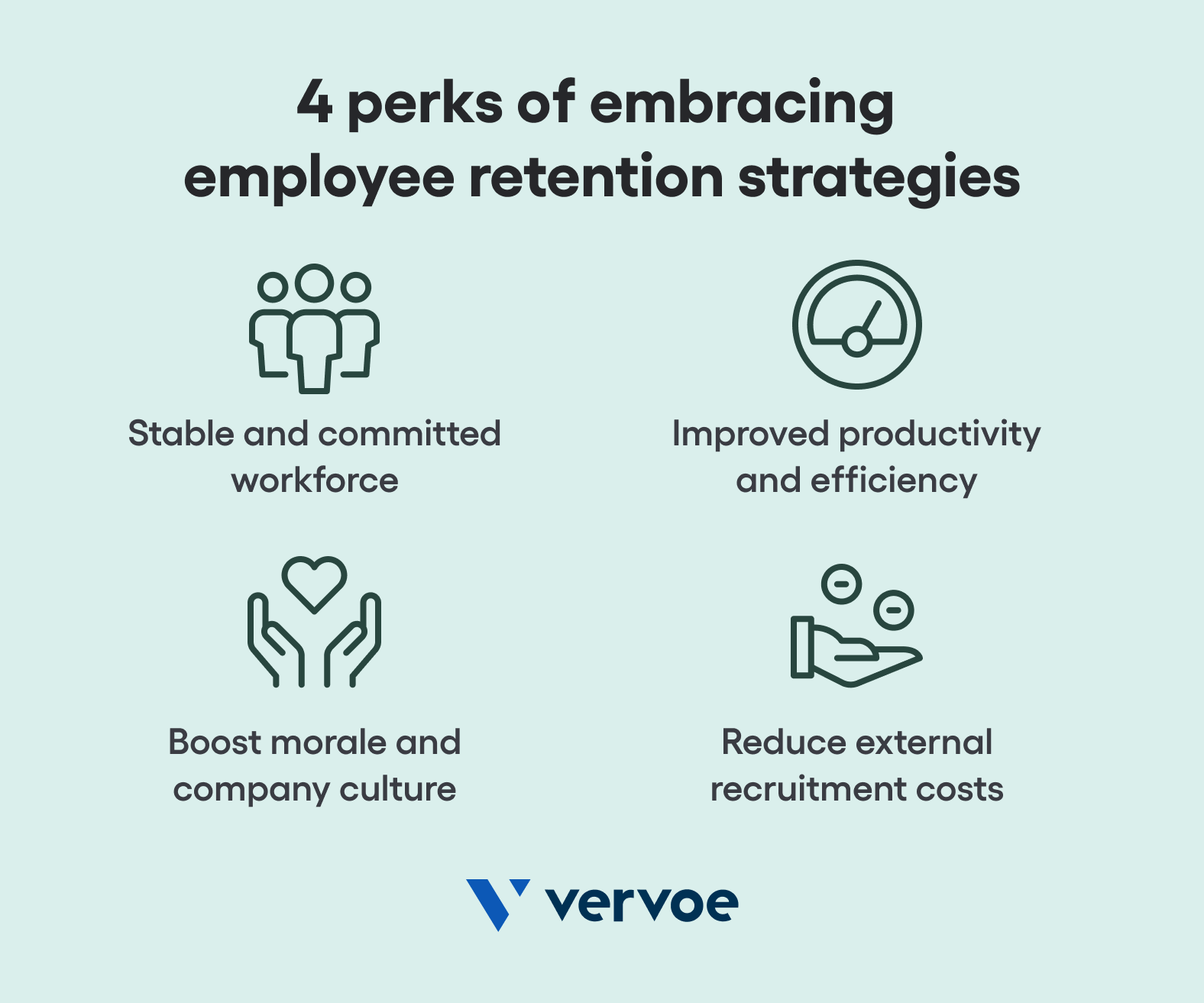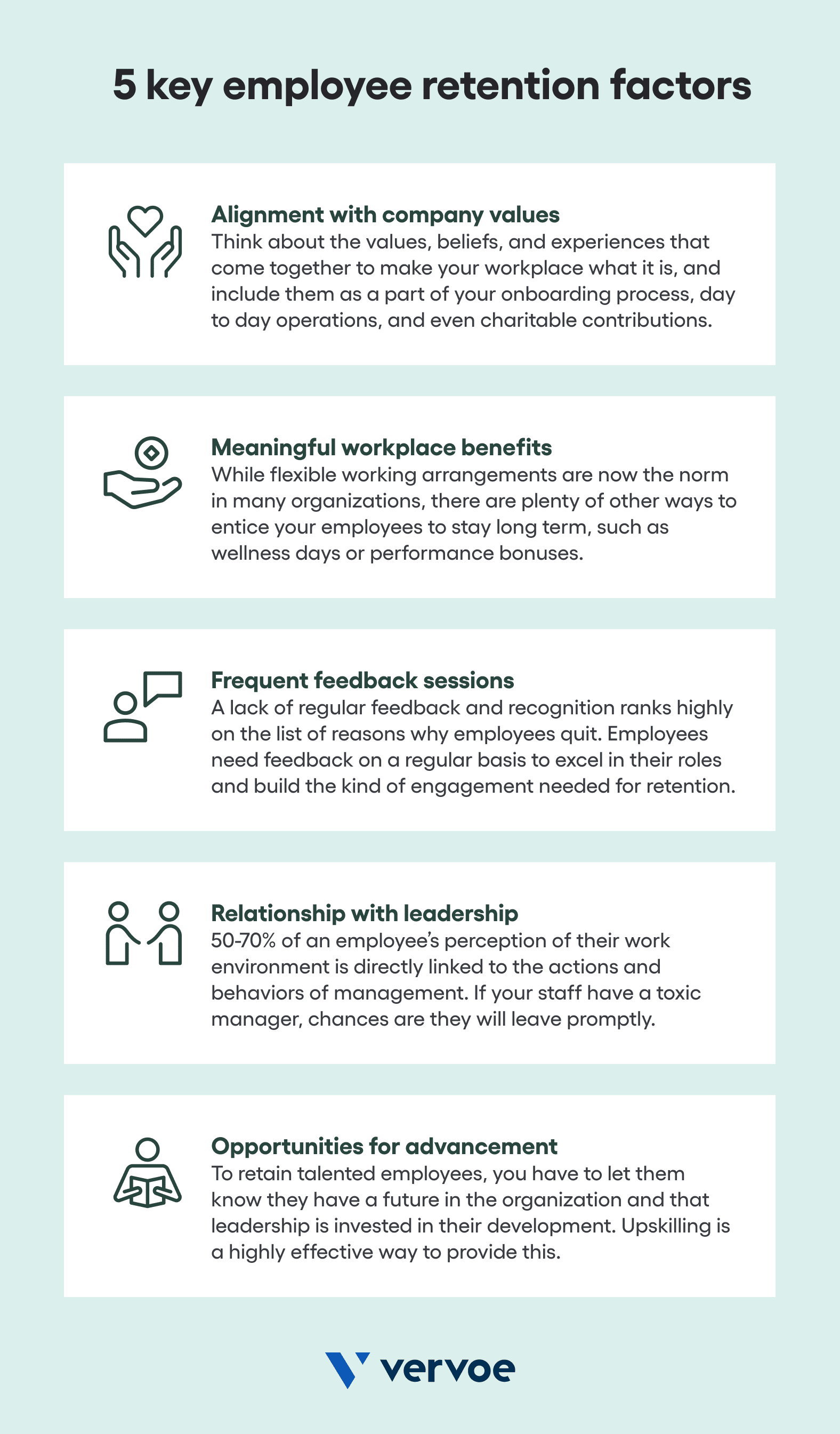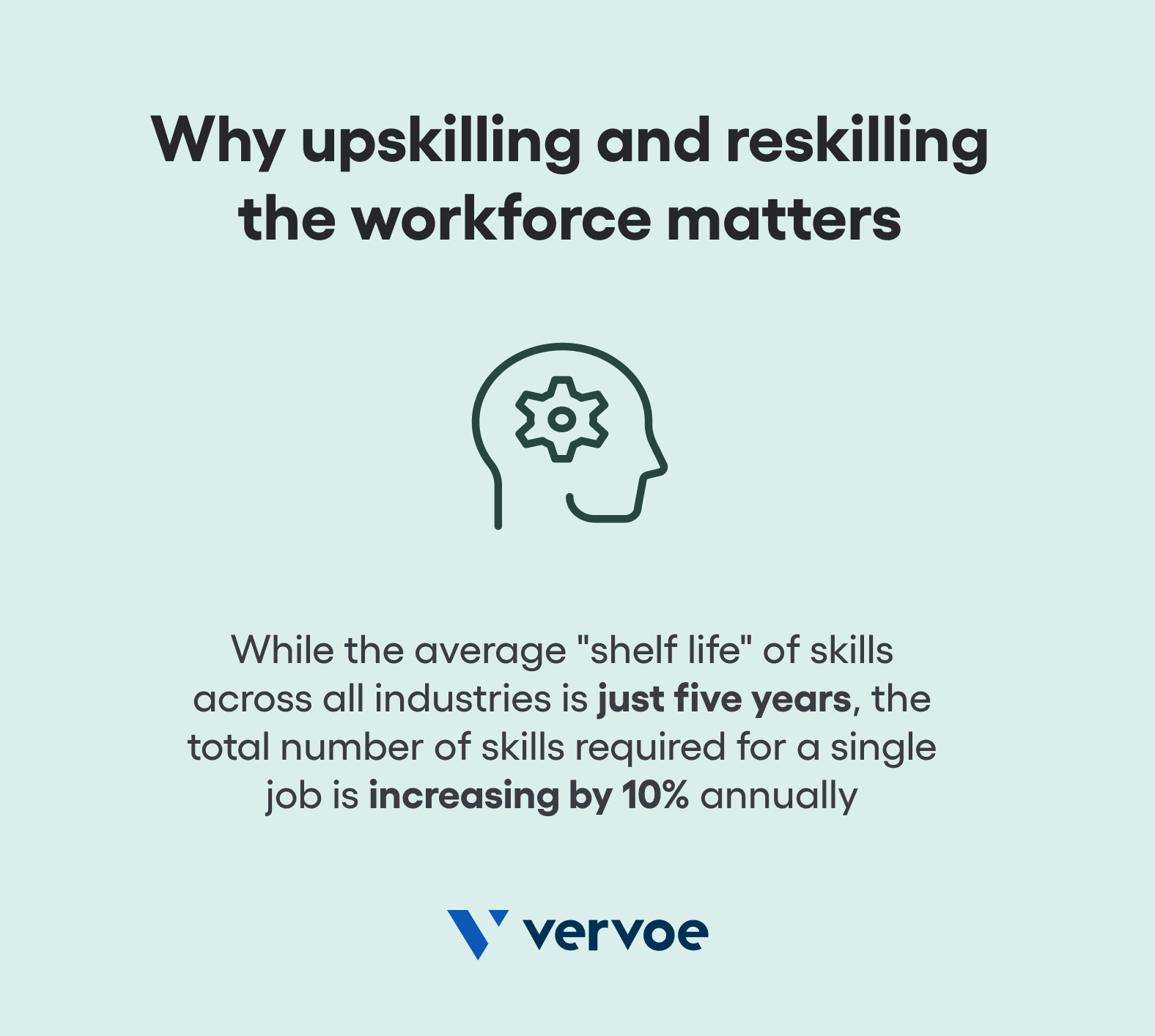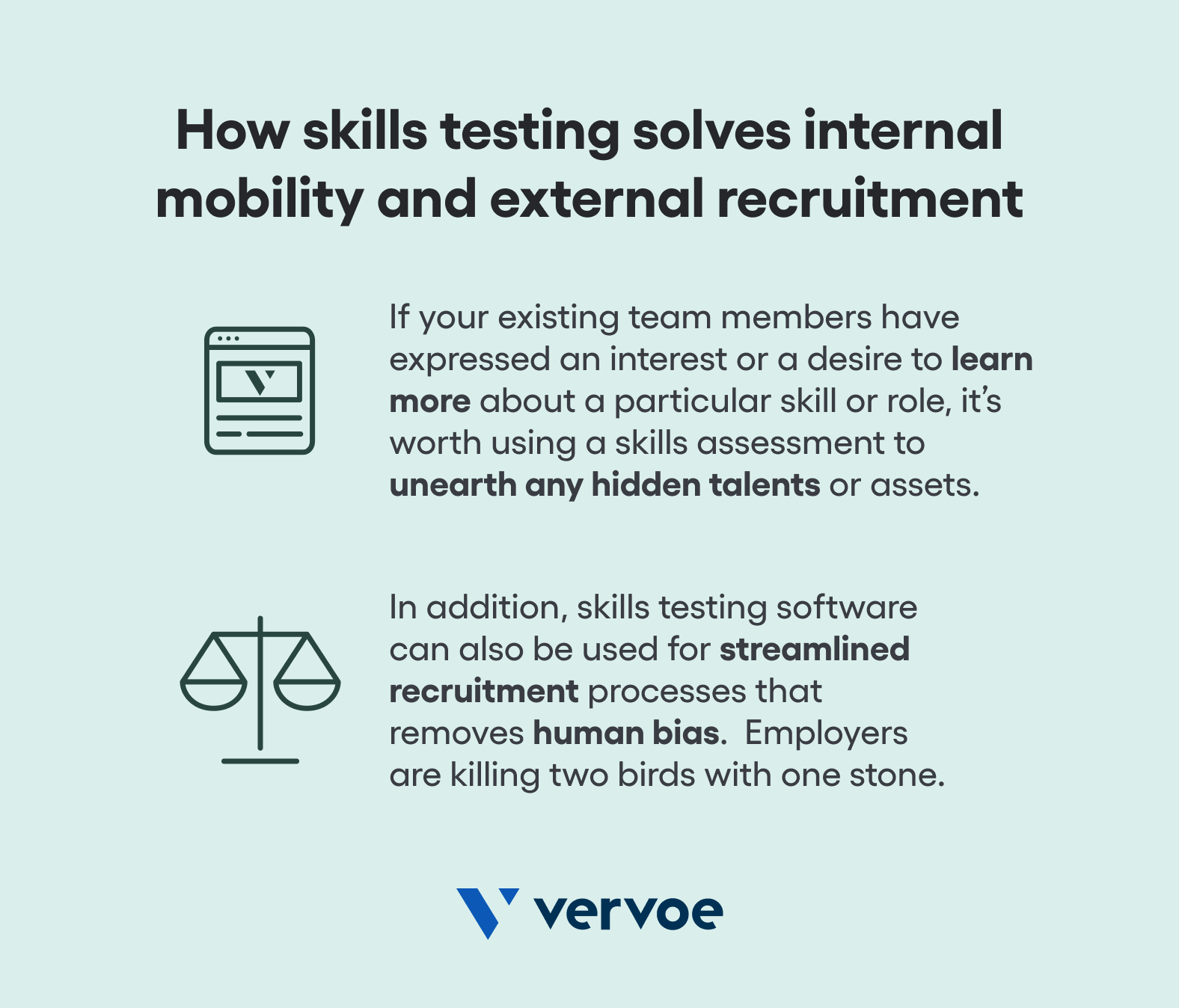Struggling to keep good staff? Without an employee retention strategy that covers upskilling and reskilling, your organization may be losing top talent.
Many of us are led to believe that staying with one employer for a long period of time indicates reliability, loyalty, experience, and even a solid sense of honor. However, variety is the spice of life – and that philosophy also extends to our careers.
While the average person will change jobs twelve times over the course of their lifetime, the median employee tenure in the United States is 4.3 years for men and 3.8 years for women.
What this means is that the average employee tenure is getting smaller, and people are less hesitant to jump ship from a job than previous generations were.
Of course, there are many factors that go into the average employee tenure, such as the employee’s age, industry, education, and gender. Most people will eventually leave their role, no matter what measures an organization takes in an attempt to retain them – but that doesn’t mean that you shouldn’t try.
Unpacking the importance of employee retention strategies
By implementing effective employee retention strategies, organizations can build a stable and committed workforce, improve productivity and efficiency, and create a positive and sustainable work environment.
The problem is, many companies make the mistake of believing that the return on investment isn’t worth it, and that good staff will eventually leave anyway.
In reality, the benefits of creating an employee retention strategy far outweigh the effort involved, and the cost of employee attrition is too big to ignore.
According to Jonathan Reyes, a Forbes Human Resources Council Member, the number one reason why people leave jobs is for career growth – or lack thereof.
“Organizations lose so much when employees leave after only a year or two, but the fact is that talent ecosystems are often built to help employees depart. The use of headhunters, LinkedIn and marketing/advertising aimed at external candidates encourage employees to look elsewhere when they want to progress their careers. Instead, organizations need to shift into an upskilling and reskilling mindset.”
Too many companies continue to rely on external recruitment, when the solution often lies in-house. There are only a limited number of individuals who may possess the skills for a given role, and there are countless reasons as to why these individuals may not even see an opening – let alone align logistically and culturally with an organization.
[Read More – The Real Cost Of Training A New Hire]
Instead of spending thousands of dollars on advertising, training and replacing an existing team member, keeping this expense in check is directly tied to two key metrics: retention and attrition.
If you’re unfamiliar with these metrics, an organization’s retention rate is the percentage of employees your business has retained over a specified time period, whereas an attrition rate looks at the exact opposite, or how many team members have left.
While it might be stating the obvious, the best way to retain employees is by making them feel valued and providing them with the opportunity for growth within your organization. To do that, approaching upskilling as an employee retention strategy is a must – but is that all it takes?

Five effective employee retention factors to consider
As the name would suggest, employee retention strategies are what we call specific plans or courses of actions that organizations use to reduce employee turnover, prevent attrition, increase retention, and foster employee engagement.
By actively embracing employee retention strategies, organizations will ultimately be able to hang onto their most talented and motivated employees, who in turn want to be a part of the company, and are focused on contributing to the organization’s overall success.
In time, this leads to increased performance, productivity, employee morale, and quality of work, and reduces turnover and employee-related problems.
While the benefits are certainly noteworthy, the route to getting there is where many companies differ.
From employee share plans to performance bonuses to “bring your dog to work” days, there are plenty of ways to keep your team happy, engaged and eager to stick around – but what are regarded as some of the most effective?
Alignment with company values
The first step in boosting employee retention is starting at the beginning by figuring out what exactly your values are. Think about the aligned values, beliefs, behaviors, and experiences that come together to make your workplace what it is, and include them as a part of your onboarding process, day to day operations, and even charitable contributions if this is something your brand can afford to commit to.
According to Buffer, 80% of Fortune 100 companies tout their values publicly. Furthermore, organizations with a high sense of purpose outperform others by 400%. Choosing to run your company on a value-based system can be difficult, and may even be painful at times – but it ultimately gives your employees (and your customers) something to get behind and be passionate about.
Meaningful workplace benefits
Allowing employees to work from home gives them the flexibility to take better care of their families and personal needs, and many people aren’t eager on the idea of being forced to head back into the office for five full days per week. In addition, offering flexibility in work schedules is another meaningful workplace benefit that encourages true work life balance, and greater autonomy.
While flexible working arrangements are now the norm in many organizations, there are plenty of other ways to entice your employees to stay long term. Forget about offering free pizza in the office on Fridays, and think more along the lines of competitive salaries, paid monthly “wellness” days, profit shares and paid parental leave schemes – staff need meaningful financial benefits that will significantly impact their quality of life.
Frequent feedback sessions
A lack of regular feedback and recognition ranks highly on the list of reasons why employees quit their jobs. Employees need feedback on a regular basis to excel in their roles and build the kind of engagement needed for retention. Not only does it provide job clarity, but also helps employees course correct when needed, develop an improvement mindset, and build confidence in their work.
However, in order for this process to be most effective, it needs to be a two-way street. Leadership being open to feedback from employees gives your team a voice, and helps them to build trust with management. While open communication will almost always be a benefit, a transparent approach to feedback exchanges also increases employee loyalty and retention.
Relationship with leadership
You’ve likely heard the phrase, “people don’t leave jobs, they leave managers.” The day-to-day interactions employees have with management strongly impact their experience at work, and how long they choose to stay for. Ensuring that leaders at all levels within the organization are modeling core values and forging trust-based relationships with staff is an important component of any organization’s employee retention strategy.
In fact, there’s even data that compounds the importance of strong leadership. According to a 25-year study by Gallup, 50-70% of an employee’s perception of their work environment is directly linked to the actions and behaviors of management. We’ve all experienced working under a toxic boss or manager, so reigning bad behavior in and replacing it with true support and mentorship is crucial for staff retention.
Opportunities for advancement
Research compiled by LinkedIn has shown that employees who spend time learning on the job are 47% less likely to be stressed, 39% more likely to feel productive and successful, 23% more able to take on additional responsibilities, and 21% more likely to feel confident and happy. To retain talented employees, you have to let them know they have a future in the organization and that leadership is invested in their development.
Interestingly, upskilling and reskilling is something that workers actually want to participate in. According to PwC Global, an overwhelming number of existing employees want to reskill, with 77% of respondents saying that they would happily learn new skills at work or even retrain entirely. As an employee retention strategy, this tactic not only benefits employers, but provides employees with a chance to advance their careers in-house.

Why upskilling and reskilling the workforce matters
Did you know that the average “shelf life” of skills needed to be effective across industries is approximately half of what it used to be? With skills proficiency lasting as little as five years, it’s also worth noting that the total number of skills required for a single job is increasing by 10% annually.
What this means is that by the time it takes for the average person to complete university and gain some on-the-job experience, the skills they’ve learned are already redundant. Furthermore, market conditions are demanding more of those same skills, placing both candidates and employers in a lose-lose situation.
The solution? Invest in what you already have.
If you take your car in for a service at the mechanic four to five times per year, the vehicle will go the distance and remain reliable for years to come. If you don’t, expect the lifespan of your automobile to shorten significantly, in addition to spending a large amount of money to replace it.
The same concept can be applied to internal mobility around the world. By upskilling and reskilling the workforce you already have, you’re investing in people who are already familiar with the inner happenings of your organization, understand your product or service, and embrace your company culture.
In return, employers can expect improved retention, higher productivity rates and internal mobility opportunities that cut the costs of external recruitment.
Considering that research from the World Economic Forum (WEF) shows that half of all employees around the world need to upskill or reskill by 2025, if you aren’t using reskilling as an employee retention strategy to futureproof your organization, you risk being left behind.

How Vervoe helps organizations with upskilling and reskilling
The key to a successful upskilling program is identifying which team members have hidden talents. So, what’s the best way to identify gaps in your team? Ideally, the process should start with an in-depth skills gap analysis.
A skills gap analysis can help you uncover any existing skills gaps you have at your organization, which skills your team is currently missing, and which employees may be best suited to further training opportunities. Be sure to base your priorities on the types of jobs that will be affected most by new technologies, and the employees who are most at risk.
If your existing team members have expressed an interest or a desire to learn more about a particular skill or role, it’s worth using a skills assessment to unearth any hidden talents or assets.
In addition, skills testing software can also be used for streamlined recruitment processes that removes human bias. Effectively, employers are killing two birds with one stone.
In fact, this is exactly why the Colorado Coalition For The Homeless chose to partner with Vervoe.
Despite the potential to develop professionally and advance their careers, CCH was experiencing a unique issue: their existing team members were so satisfied with their current roles that they had little interest in progressing to program management positions.
In the interest of retaining the remarkable talent they already possessed, CCH went in search of a solution that would allow them to see who was ready to take on more development, while also being able to process a large volume of suitable people objectively and accurately.
By embracing skills-based hiring practices at all stages of the recruitment journey, Jacob Wessley, the Director of Outreach and Engagement at CCH, says the team couldn’t be happier with the results they’ve seen from using Vervoe.
“It’s created a situation where people know there’s internal mobility options. When we make a new hire, it’s a helpful recruiting tool knowing that within a year, they’ll be eligible to be a case manager too, which comes with a pay bump. We’ve seen dozens of staff move through this progression, and overall, they’re appreciative that there’s an opportunity to assess their skills and move them forward accordingly.”
If your organization is struggling to implement effective employee retention strategies, explore options for upskilling, or are even looking for a better way to address recruitment, the answer is Vervoe.

Talent stands out with job simulations
Vervoe is an end-to-end AI-powered solution that is proudly revolutionizing the hiring process through skills testing, job simulations, and machine learning recruitment.
By empowering businesses to create role specific assessments designed to suit the unique requirements of a position, Vervoe predicts performance through skills-based hiring practices that showcase the talent of every candidate.
Ultimately, our job simulations focus on the work — and not the person. To see people do the job before they get the job, book a demo today and let our experienced team run you through Vervoe’s full range of ready-made and tailored solutions.


















